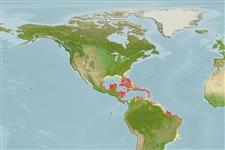>
Blenniiformes (Blennies) >
Blenniidae (Combtooth blennies) > Salariinae
Etymology: Ophioblennius: Greek, ophis = serpent + Greek, blennios = mucus (Ref. 45335).
Eponymy: Dr Charles Freeman Williams McClure (1865–1955) was an American anatomist and embryologist. [...] (Ref. 128868), visit book page.
Environment: milieu / climate zone / depth range / distribution range
Ecologie
marien rifbewoner. Tropical
Western Central Atlantic: North Carolina, Florida, Caribbean (Bermuda population may be distinct species).
Grootte / Gewicht / Leeftijd
Maturity: Lm ? range ? - ? cm
Max length : 12.2 cm TL mannelijk / geslacht onbekend; (Ref. 26340)
Dorsale stekels (totaal) : 12; Dorsale zachte stralen (totaal) : 19 - 21; Anale stekels: 2; Anale zachte stralen: 20 - 21; Wervels: 33. Lateral line consists of 2 disconnected, elongate portions where the anterior portion overlaps with the anterior end of the ventral portion (Ref. 43469).
Adults inhabit shallow, clear waters with coral or rock bottoms (Ref. 5521). Territorial (Ref. 9710). Oviparous. Eggs are demersal and adhesive (Ref. 205), and are attached to the substrate via a filamentous, adhesive pad or pedestal (Ref. 94114). Larvae are planktonic, often found in shallow, coastal waters (Ref. 94114).
Levenscyclus en paargedrag
Maturiteit | Voortplanting | Paaien | Eieren | Fecunditeit | Larven
Oviparous, distinct pairing (Ref. 205).
Springer, V.G., 1962. A review of the blenniid fishes of the genus Ophioblennius Gill. Copeia 1962(2):426-433. (Ref. 9861)
Status op de Rode Lijst van het IUCN (Ref. 130435: Version 2024-2)
Gevaar voor de mens
Harmless
Gebruik door de mens
Visserij: van geen belang; Aquarium: Commercieel
Tools
Speciale rapporten
Download XML
Internetbronnen
Estimates based on models
Preferred temperature (Ref.
123201): 26.2 - 28.2, mean 27.4 °C (based on 644 cells).
Fylogenetische diversiteitsindex (Ref.
82804): PD
50 = 0.5312 [Uniqueness, from 0.5 = low to 2.0 = high].
Bayesian length-weight: a=0.01122 (0.00514 - 0.02450), b=3.04 (2.87 - 3.21), in cm total length, based on all LWR estimates for this body shape (Ref.
93245).
Trofisch niveau (Ref.
69278): 2.5 ±0.1 se; based on size and trophs of closest relatives
Weerstandsvermogen (Ref.
120179): Hoog, minimale populatieverdubbelingstijd minder dan 15 maanden (Preliminary K or Fecundity.).
Fishing Vulnerability (Ref.
59153): Low vulnerability (10 of 100).
Nutrients (Ref.
124155): Calcium = 115 [61, 188] mg/100g; Iron = 0.847 [0.518, 1.364] mg/100g; Protein = 18.3 [17.2, 19.4] %; Omega3 = 0.136 [0.086, 0.219] g/100g; Selenium = 25.8 [14.8, 49.0] μg/100g; VitaminA = 107 [31, 353] μg/100g; Zinc = 2.32 [1.60, 3.25] mg/100g (wet weight);
